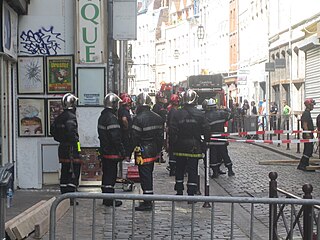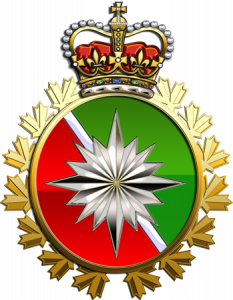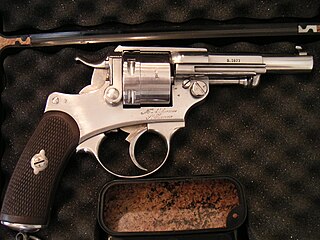
Military ranks are a system of hierarchical relationships, within an armed forces, police, intelligence agencies or other institutions organized along military lines. The military rank system defines dominance, authority, and responsibility in a military hierarchy. It incorporates the principles of exercising power and authority into the military chain of command – the succession of commanders superior to subordinates through which command is exercised. The military chain of command constructs an important component for organized collective action.

A non-commissioned officer (NCO) is a military officer who has not earned a commission. Non-commissioned officers usually obtain their position of authority by promotion through the enlisted ranks In contrast, commissioned officers usually enter directly from a military academy, Officer Candidate School (OCS), or Officer Training School (OTS) after receiving a post-secondary degree.

A sapper, also called pioneer or combat engineer, is a combatant or soldier who performs a variety of military engineering duties, such as breaching fortifications, demolitions, bridge-building, laying or clearing minefields, preparing field defenses, and road and airfield construction and repair. They are also trained to serve as infantry personnel in defensive and offensive operations. A sapper's duties are devoted to tasks involving facilitating movement, defense and survival of allied forces and impeding those of enemies. The term "sapper" is used in the British Army and Commonwealth nations, the Polish Army and the U.S. military. The word "sapper" comes from the French word sapeur, itself being derived from the verb saper.

A carabinier is in principle a soldier armed with a carbine. A carbiniere is a carabiniere musket or rifle. Carabiniers were first introduced in the late 17th century and were commonplace by the beginning of the Napoleonic Wars in Europe. The word is derived from the identical French word carabinier.
Commandant is a title often given to the officer in charge of a military training establishment or academy. This usage is common in English-speaking nations. In some countries it may be a military or police rank. It is also often used to refer to the commander of a military prison or prison camp.

The Paris Fire Brigade is a French Army unit which serves as the primary fire and rescue service for Paris, the city's inner suburbs and certain sites of national strategic importance.

The fire service in France is organised into local fire services which mostly cover the Departments of France, with a few exceptions. There are two types of fire service:

The Compagnie des Carabiniers du Prince is the Infantry branch of the Force Publique, and one of the limited number of militaries that recruits foreigners. Although Monaco's defence is the responsibility of France, Monaco maintains a small force for the protection of the Sovereign and the Prince's Palace. Formed by Prince Honoré IV in 1817, the unit was re-organized in 1909. The company numbers 119 officers and men. Whilst the NCOs and soldiers are local, the officers have served in the French Army or the Republican Guard. Along with the Corps des Sapeurs-Pompiers, the Carabiniers form Monaco's total public forces.

Rank insignia in the French Army are worn on the sleeve or on shoulder marks of uniforms, and range up to the highest rank of Marshal of France, a state honour denoted with a seven-star insignia that was last conferred posthumously on Marie Pierre Koenig in 1984.
Finnish military ranks form a system that incorporates features from Swedish, German, and Russian armed forces. In addition, the system has some typically Finnish characteristics that are mostly due to the personnel structure of the Finnish Defence Forces. The ranks have official names in Finnish and Swedish languages and official English translations. The Swedish forms are used in all Swedish-languages communications in Finland, e.g. in Swedish-speaking units of Finnish Defence Force. The system of ranks in the Swedish Armed Forces is slightly different.

The Intelligence Branch is a personnel branch of the Canadian Forces (CF) that is concerned with providing relevant and correct information to enable commanders to make decisions.

Law enforcement in Monaco is provided by an armed national police force consisting of 515 men and women. With 515 police officers for 35,000 people in 1.98 km2, Monaco has the largest police force and police presence in the world on both a per-capita and per-area basis. Its police includes a specialist unit which operates patrol and surveillance boats. There is also a militarised bodyguard unit for the Prince and his palace called the Compagnie des Carabiniers du Prince which numbers exactly 116 officers and men, and is equipped with modern weapons including M16 rifles and 9mm pistols, and an armed and well-trained Corps des Sapeurs-Pompiers, which provides an extensive civil defense service in support of law enforcement, in addition to its fire and rescue services. In 2006 the assault rate was 407.2 per 100,000 and the rape rate 5.8 per 100,000. The murder rate was 2.91 per 100,000 in 2006.

The service revolver model 1873 Chamelot-Delvigne was the first double-action revolver used by the French Army. It was produced by Manufacture d'armes de Saint-Étienne from 1873 to 1887 in about 337,000 copies. Although replaced by the Modele 1892 revolver, it was nevertheless widely used during the First World War, and issued to reserve units in 1940. The Resistance made widespread use of it during the Occupation.
Commandant is a military or police rank. In the French, Spanish, Irish and Monegasque armed forces it is a rank equivalent to major while in Belgium it is a unique rank. In South Africa for most of the second half of the 20th century, commandant was a rank equivalent to lieutenant-colonel.

The National Defence Medal is a French military decoration. It was created by Charles Hernu, Minister of Defence and established by decree on 21 April 1982. It rewards particularly honourable service rendered by military personnel for their participation in operational activities. The medal has three levels: Gold, Silver and Bronze.
Rank insignia in the French Air and Space Force are worn on the sleeve or on shoulder marks of uniforms
Major in France, is a senior superior military rank across various military and security institutions with history dating back well beyond the 18th century.
The Prince's Band of Carabiniers is a part-time military band assigned to provide musical support to the Prince Albert II of Monaco, who is the head of state and the ceremonial head of the Force Publique. Its home unit is the Compagnie des Carabiniers du Prince, which is responsible for the country's defence. All members of the band are trained dually music and in the trades of non-band members. The 26-members of the band are referred to as "rifle-musicians" while the band director is titled a Maréchal des Logis Chef. In 1978, the title of "Fanfare de la Companies des Carabiniers" was adopted.

Corps des Sapeurs-Pompiers de Monaco is a firefighting and civil defense department of military force of Monaco. The Department is responsible for fighting fires and risks of all kinds, providing personal assistance and protecting property on the territory of the Principality of Monaco and neighboring French municipalities on the basis of a 1970 bilateral Mutual Assistance Agreement.































